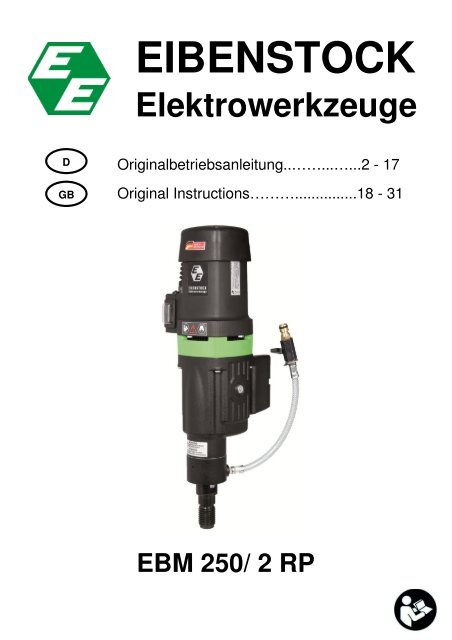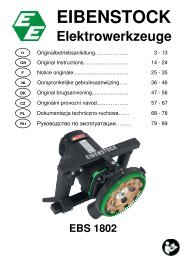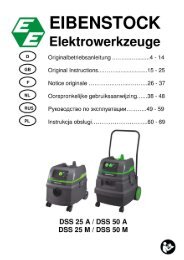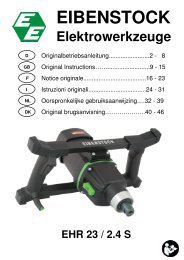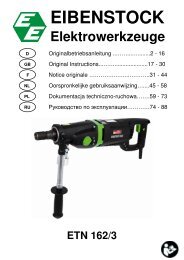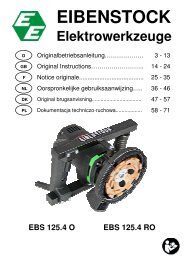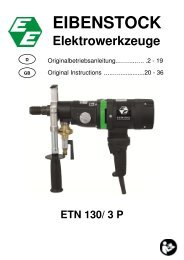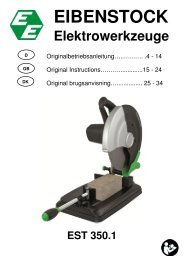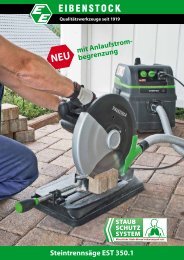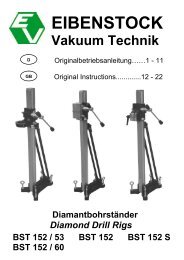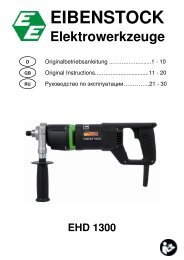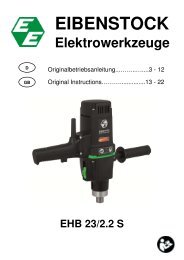Achtung! - Eibenstock
Achtung! - Eibenstock
Achtung! - Eibenstock
Erfolgreiche ePaper selbst erstellen
Machen Sie aus Ihren PDF Publikationen ein blätterbares Flipbook mit unserer einzigartigen Google optimierten e-Paper Software.
D<br />
GB<br />
EIBENSTOCK<br />
Elektrowerkzeuge<br />
Originalbetriebsanleitung..……...…...2 - 17<br />
Original Instructions………...............18 - 31<br />
EBM 250/ 2 RP
Wichtige Sicherheitshinweise<br />
Warnzeichen<br />
DEUTSCH<br />
Warnung vor allgemeiner Gefahr<br />
Warnung vor gefährlicher elektrischer Spannung<br />
Warnung vor heißer Oberfläche<br />
Maschine, Bohrkrone und Bohrständer sind schwer<br />
– Vorsicht Quetschgefahr<br />
Reiß- bzw. Schneidgefahr<br />
Zu Ihrem Schutz sollten Sie folgende Schutzmaßnahmen treffen<br />
Gehörschutz benutzen<br />
Augenschutz benutzen<br />
Schutzhelm benutzen<br />
Schutzhandschuhe benutzen<br />
Schutzschuhe benutzen<br />
2
Gerätekennwerte<br />
Diamantkernbohrgerät EBM 250/2 RP<br />
Nennspannung: 230 V ~<br />
Leistungsaufnahme: 2500 W<br />
Nennstrom: 11,5 A<br />
Frequenz: 40-60 Hz<br />
Max. Bohrdurchmesser: 250 mm<br />
Werkzeugaufnahme: 1¼" UNC<br />
Schutzklasse: I<br />
Schutzgrad: IP 20<br />
Gewicht: ca. 10,5 kg<br />
Funkentstörung nach: EN 55014 und EN 61000<br />
Gang Nenndrehzahl max. Bohr-durchmesser<br />
lieferbares Sonderzubehör:<br />
360 min -1 250 mm<br />
850 min -1 152 mm<br />
Artikel Bestell Nr.<br />
Diamantbohrständer mit Schnellwechseladapter BST 250 09631<br />
Befestigungsset Beton/ Gestein 35720<br />
Kupferringe zum leichten Lösen der Bohrkrone 35450<br />
Adapter 1 / ¼" i – ½" i 35116<br />
Schnellspannsäule 35730<br />
Wasserdruckgefäß 10l Metall 35810<br />
Nass / Trockensauger DSS 25 A 09915<br />
Diamantbohrkronen Ø60 – 252 mm<br />
Bohrkronenverlängerungen<br />
Lieferumfang<br />
Diamantkernbohrgerät mit Kugelhahn und GARDENA–Stecknippel, PRCD–<br />
Schutzschalter, Bedienungsanleitung, je 1 Stück Einmaulschlüssel SW 32<br />
und SW 41 im Maschinenkarton.<br />
3
Bestimmungsgemäßer Gebrauch<br />
Die Diamant- Kernbohrmaschine EBM 250/2 RP ist für den professionellen<br />
Einsatz bestimmt und darf nur von unterwiesenen Personen bedient<br />
werden.<br />
In Verbindung mit den entsprechenden Nassbohrkronen ist die Maschine<br />
zum Bohren von Beton, Stein und Mauerwerk ausschließlich im<br />
Nassschnitt bestimmt.<br />
Sie darf nur in einem dafür geeigneten Diamantbohrständer betrieben<br />
werden.<br />
Sicherheitshinweise<br />
Gefahrloses Arbeiten mit dem Gerät ist nur möglich,<br />
wenn Sie die Bedienungsanleitung vollständig lesen und<br />
die darin enthaltenen Anweisungen strikt befolgen.<br />
Zusätzlich müssen die allgemeinen Sicherheitshinweise<br />
im beigelegten Heft befolgt werden. Lassen Sie sich vor<br />
dem ersten Gebrauch praktisch einweisen.<br />
Wird bei der Arbeit die Anschlussleitung beschädigt oder<br />
durchtrennt, diese nicht berühren, sondern sofort den<br />
Netzstecker ziehen. Gerät niemals mit beschädigter<br />
Anschlussleitung betreiben.<br />
Überprüfen Sie vor dem Bohren in Decken und Wänden<br />
die Bohrstelle auf verdeckt liegende Strom-, Gas- und<br />
Wasserleitungen.<br />
Überprüfen Sie den Arbeitsbereich, z.B. mit einem<br />
Metallortungsgerät.<br />
Konsultieren Sie den verantwortlichen Statiker vor<br />
Beginn ihrer Arbeit zur Festlegung der genauen Position<br />
der Bohrung.<br />
Sichern Sie bei Durchbohrungen durch Decken den<br />
Bereich von unten ab, da der Bohrkern nach unten<br />
herausfallen kann.<br />
Achten Sie darauf dass die Maschine keinem direkten<br />
Regen ausgesetzt ist.<br />
� Arbeiten Sie nicht in explosionsgefährdeter Umgebung.<br />
� Arbeiten Sie nicht auf Leitern.<br />
4
� Asbesthaltige Materialien dürfen nicht bearbeitet werden.<br />
� Tragen Sie das Gerät niemals am Kabel und überprüfen Sie vor jeder<br />
Benutzung Gerät, Kabel und Stecker. Lassen Sie Schäden nur von<br />
einem Fachmann beseitigen. Stecker nur bei ausgeschalteter Maschine<br />
in die Steckdose stecken.<br />
� Manipulationen am Gerät sind nicht erlaubt.<br />
� Lassen Sie die Kernbohrmaschine nur unter Aufsicht arbeiten. Ziehen<br />
Sie den Netzstecker, und überprüfen Sie, dass der Schalter<br />
ausgeschaltet ist, wenn die Kernbohrmaschine unbeaufsichtigt bleibt,<br />
bei Auf- und Abbauarbeiten, bei Spannungsabfall, beim Einsetzen bzw.<br />
bei der Montage eines Zubehörteiles.<br />
� Schalten Sie die Maschine ab, wenn Sie aus irgendeinem Grund<br />
stehen bleibt. Sie vermeiden damit das plötzliche Anlaufen im<br />
unbeaufsichtigten Zustand.<br />
� Benutzen Sie das Gerät nicht, wenn ein Teil des Gehäuses defekt ist,<br />
bzw. bei Beschädigungen an Schalter, Zuleitung oder Stecker.<br />
� Elektrowerkzeuge müssen in regelmäßigen Abständen einer<br />
Sichtprüfung durch den Fachmann unterzogen werden.<br />
� Kabel immer nach hinten von der Maschine wegführen.<br />
� Beim Betreiben des Kernbohrgerätes darf in keiner Gebrauchslage<br />
Kühlwasser in den Motor und die elektrischen Einbauteile<br />
eindringen.<br />
� Überkopfbohrungen nur mit geeigneten Schutzvorkehrungen<br />
(Wasserauffangvorrichtung) durchführen.<br />
� Tritt Wasser aus der Überlaufbohrung am Getriebehals aus, brechen<br />
Sie die Arbeiten ab und lassen Sie das Kernbohrgerät in einer<br />
autorisierten Fachwerkstatt reparieren.<br />
� Schalten Sie nach einer Unterbrechung Ihrer Arbeit die<br />
Kernbohrmaschine nur dann ein, nachdem Sie sich davon überzeugt<br />
haben, dass sich die Bohrkrone frei drehen lässt.<br />
� Nicht in rotierende Teile fassen.<br />
� Personen unter 16 Jahren dürfen das Gerät nicht benutzen.<br />
� Der Benutzer und die sich in der Nähe aufhaltenden Personen müssen<br />
während der Benutzung des Gerätes eine geeignete Schutzbrille,<br />
Schutzhelm, Gehörschutz, Schutzhandschuhe und Sicherheitsschuhe<br />
benutzen.<br />
� Arbeiten Sie stets konzentriert. Gehen Sie überlegt vor und<br />
verwenden Sie das Gerät nicht, wenn Sie unkonzentriert sind.<br />
Weitere Sicherheitshinweise entnehmen sie bitte der Anlage!<br />
5
41,3<br />
10<br />
Montage am Bohrständer<br />
98<br />
79,5<br />
M8x16<br />
Die EBM 250/2 RP wird am Getriebefuß mit<br />
4 Innensechskantschrauben M8 am<br />
Bohrständer befestigt. Setzen Sie die<br />
Maschine nur in einen stabilen, mit präzisen<br />
Führungen versehenen Bohrständer ein.<br />
Achten Sie darauf, dass die<br />
Maschinenachse parallel zur<br />
Bohrständersäule verläuft.<br />
Verwenden Sie nur Bohrständer mit<br />
ausreichender Standsicherheit.<br />
Die Verwendung eines Wassersammelrings<br />
ist zu empfehlen.<br />
Elektrischer Anschluss<br />
Die EBM 250/2 RP ist in Schutzklasse I ausgeführt. Zum Schutz des<br />
Bedieners darf die Maschine nur über eine Fehlerstromschutzeinrichtung<br />
betrieben werden und wird deshalb standardmäßig mit einem im Kabel<br />
integriertem PRCD–Schutzschalter zum Einsatz an einer<br />
Schutzkontaktsteckdose geliefert.<br />
!<br />
<strong>Achtung</strong>!<br />
� Der PRCD – Schutzschalter darf nicht im Wasser liegen.<br />
� PRCD – Schutzschalter nicht zum Ein- und Ausschalten<br />
der Maschine verwenden.<br />
� Vor Arbeitsbeginn die ordnungsgemäße Funktion durch<br />
Drücken der TEST – Taste überprüfen.<br />
Prüfen Sie vor Inbetriebnahme die Übereinstimmung der Netzspannung<br />
und -frequenz mit den auf dem Typenschild angegebenen Daten.<br />
Spannungsabweichungen von + 6 % bis – 10 % sind zulässig.<br />
Verwenden Sie nur 3-adriges Verlängerungskabel mit Schutzleiter und<br />
ausreichendem Querschnitt (mind. 2,5 mm²). Ein zu schwacher Querschnitt<br />
kann zu übermäßigem Leistungsverlust und zur Überhitzung von Maschine<br />
und Kabel führen.<br />
6
Wasseranschluss<br />
Wenn die Bohrkrone nicht ausreichend mit Wasser gekühlt ist, können sich<br />
die Diamantsegmente erwärmen, was diese beschädigt und schwächt.<br />
Deshalb sollen Sie sich immer vergewissern, dass das Kühlungssystem<br />
nicht verstopft ist.<br />
Zur Versorgung des Bohrgerätes mit Wasser gehen Sie bitte wie folgt vor:<br />
� Schließen Sie die Maschine über das GARDENA-Stecknippel an die<br />
Wasserversorgung oder ein Wasserdruckgefäß an.<br />
� Betreiben Sie die Maschine nur mit sauberem Wasser und<br />
ausreichender Wasserzufuhr, da im Trockenbetrieb die Dichtungen<br />
beschädigt werden.<br />
� <strong>Achtung</strong>! Der maximale Wasserdruck sollte 3 bar nicht überschreiten!<br />
� Vergewissern Sie sich, dass die Segmente genug gekühlt sind. Ist das<br />
Bohrwasser klar, ist die Kühlung ausreichend.<br />
� Verschließen Sie das soeben gebohrte Loch wenn Sie dieses<br />
vergrößern wollen, um eine ausreichende Kühlwasserzufuhr erzielen zu<br />
können.<br />
� Bei Überkopfarbeiten müssen Sie immer einen Wassersammelring<br />
benutzen.<br />
� Entleeren Sie das Wassersystem bei Frostgefahr.<br />
Getriebeumschaltung<br />
Die EBM 250/2 P besitzt ein mechanisches 2-Gang Ölbadgetriebe.<br />
Passen Sie die Drehzahl der Maschine dem Bohrdurchmesser an<br />
(Angaben siehe Gerätekennwerte).<br />
Drehen Sie den Getriebeschalter soweit in den schnelleren bzw.<br />
langsameren Gang. Der Drehzahlwechsel ist nur bei stillstehender<br />
Maschine vorzunehmen, eventuell ist durch leichtes Verdrehen der<br />
Arbeitsspindel der Schaltvorgang zu unterstützen.<br />
!<br />
Warnung!<br />
� Nie mit Gewalt und nur im Auslauf oder Stillstand der<br />
Maschine umschalten!<br />
� Verwenden Sie zum Umschalten keine Werkzeuge wie z.B.<br />
Zange oder Hammer!<br />
7
Bohrkronenwechsel<br />
Vorsicht!<br />
Das Werkzeug ist schwer und kann durch den Einsatz oder durch<br />
Schärfen heiß werden. Sie können sich die Hände verbrennen, sich an<br />
den Segmenten schneiden bzw. reißen oder quetschen.<br />
Benutzen Sie für den Werkzeugwechsel deshalb immer<br />
Arbeitsschutzhandschuhe.<br />
Die Bohrspindel hat Rechtsgewinde.<br />
Verwenden Sie als Gegenhalter immer einen Maulschlüssel SW 32, der an<br />
der Bohrspindel angesetzt wird.<br />
Lösen Sie die Bohrkrone niemals mit (Hammer-)Schlägen, da so die<br />
Kernbohrmaschine beschädigt wird.<br />
Etwas wasserfestes Fett, aufgetragen auf dem Bohrspindelgewinde und ein<br />
Kupferring zwischen Spindel und Bohrkrone erleichtern das Lösen der<br />
Bohrkrone.<br />
Betreiben der Bohreinheit<br />
Um die Maschine sicher zu betreiben, beachten Sie bitte folgende<br />
Hinweise:<br />
Angaben zum Einsatzort<br />
� Befreien Sie den Einsatzort von allem, was den Arbeitsvorgang<br />
behindern könnte.<br />
� Achten Sie auf ausreichende Beleuchtung des Einsatzortes.<br />
� Halten Sie die angegebenen Bedingungen für den Anschluss an die<br />
Stromversorgung ein.<br />
� Verlegen Sie die Elektroleitungen so, dass eine Beschädigung durch<br />
das Werkzeug ausgeschlossen ist.<br />
� Vergewissern Sie sich, dass Sie ständig ausreichend Sicht auf den<br />
Arbeitsbereich haben und jederzeit alle erforderlichen<br />
Bedienungselemente und Sicherheitseinrichtungen erreichen können.<br />
� Halten Sie andere Personen von Ihrem Arbeitsbereich fern, um Unfälle<br />
zu vermeiden.<br />
8
Raumbedarf für Betrieb und Wartung<br />
Halten Sie wenn möglich ca. 2 m um die Maschine für Betrieb und Wartung<br />
frei, so dass Sie sicher arbeiten können und bei Betriebsstörungen sofort<br />
eingegriffen werden kann.<br />
Vorbereitung<br />
� Wenn Sie in Blöcke bohren, stellen Sie sicher, dass die Blöcke gut<br />
verankert und befestigt sind.<br />
� Bevor Sie in tragende Teile bohren, vergewissern Sie sich, dass Sie die<br />
Statik nicht verletzen. Befolgen Sie die Anweisungen der für die<br />
Planung verantwortlichen Fachleute.<br />
� Stellen Sie sicher, dass Sie weder Gas- bzw. Wasserleitungen, noch<br />
Stromkabel beim Bohren beschädigen können.<br />
� Vergewissern Sie sich, dass Sie keine Metallteile der Maschine<br />
während des Bohrens von Wänden und Böden, wo Stromkabel unter<br />
Wasser liegen könnten, berühren.<br />
� Stellen Sie sicher, dass der Bohrkern beim Herausfallen niemanden<br />
verletzen bzw. nichts beschädigen kann. Beräumen und sichern Sie<br />
den Arbeitsbereich.<br />
� Falls der Bohrkern beim Herausfallen Schäden verursachen könnte,<br />
bauen Sie eine entsprechende Vorrichtung auf, die den Kern<br />
zurückhält.<br />
� Vergewissern Sie sich, dass die Bohrkrone richtig befestigt ist.<br />
� Setzen Sie in Abhängigkeit vom zu bearbeitenden Material das richtige<br />
Werkzeug ein.<br />
Befestigung des Bohrständers<br />
Das Diamantkernbohrgerät EBM 250/2 RP darf nur in einem Bohrständer<br />
montiert betrieben werden.<br />
Da der Bohrständer nicht Bestandteil des Lieferumfanges ist, weisen wir auf<br />
einige wichtige Befestigungsvarianten hin.<br />
Beachten Sie bitte hierzu die Betriebsanleitung für den Bohrständer.<br />
Achten Sie bei der Vakuumbefestigung auf ein ausreichend hohes<br />
Vakuum (min. – 0,8 bar). Sorgen Sie dafür, dass die Dichtungen nicht<br />
verschlissen sind.<br />
9
<strong>Achtung</strong>! Nicht für Wand- und Deckenbohrungen!<br />
Vergessen Sie nicht, dass man die Nivellierschraube nur bis zu einem<br />
gewissen Punkt herausdrehen kann, um das Vakuum nicht zu<br />
zerstören.<br />
Die am häufigsten angewendete Befestigungsart ist die Dübelbefestigung.<br />
Benutzen sie möglichst Metalldübel. Der Dübeldurchmesser darf nicht<br />
kleiner als 12 mm sein.<br />
� Um die Bohreinheit richtig zu befestigen, benötigen Sie das<br />
Befestigungs- Set (Bestell Nr. 35721)<br />
� Bohren Sie ein Loch mit Durchmesser 15 mm, 50 mm tief und befreien<br />
Sie dieses von Staub.<br />
� Setzen Sie einen Dübel ein und spreizen Sie diesen mit Hilfe des<br />
Setzeisens auf.<br />
� Schrauben Sie die Gewindestange in den Dübel.<br />
� Stellen Sie die Bohreinheit mit dem Langloch im Fuß auf die<br />
Gewindestange.<br />
� Legen Sie die Scheibe auf und schrauben Sie die Flügelmutter ganz<br />
fest.<br />
� Justieren Sie die Bohreinheit mittels der vier Schrauben in der<br />
Fußplatte.<br />
senkrecht Bohren<br />
Bohren<br />
� Schalten Sie den PRCD auf On.<br />
� Öffnen Sie die Wasserzuführung.<br />
� Schalten Sie den Motor ein, ohne dass die Bohrkrone die Fläche<br />
berührt.<br />
� Drehen Sie den Handgriff, um die Bohrkrone zu senken, bis sie die<br />
Oberfläche berührt.<br />
� Um eine exakte Zentrierung der Bohrkrone zu erhalten, halten Sie beim<br />
ersten Zentimeter Schnitttiefe den Vorschub gering.<br />
� Sie können dann schneller bohren. Eine zu niedrige<br />
Bohrgeschwindigkeit schränkt die Leistung ein. Bei einer zu hohen<br />
Bohrgeschwindigkeit werden die Diamantsegmente schnell stumpf.<br />
10
schräg Bohren<br />
� Entfernen Sie die Schraube in der Fußplatte, welche die Säule bei 90°<br />
arretiert.<br />
� Lockern Sie die zwei Schrauben am Fuß der Säule, und schwenken<br />
Sie die Säule bis zum gewünschten Winkel.<br />
� Ziehen Sie die zwei Schrauben wieder fest.<br />
� Bohren Sie am Anfang sehr langsam, da die Krone nur mit einem<br />
Bruchteil ihrer Schnittfläche ins Material greift. Wenn Sie zu schnell<br />
oder mit einem zu hohen Druck bohren kann die Krone verlaufen.<br />
Wenn Sie während des Bohrvorganges feststellen, dass die Vorschub-<br />
geschwindigkeit sehr gering wird, dass Sie mehr Kraft aufwenden müssen<br />
und dass das Wasser, das aus dem Bohrloch austritt, klar und mit einigen<br />
Metallsplittern versetzt ist, sind Sie auf Armierungseisen getroffen.<br />
Reduzieren Sie den Druck auf die Bohrkrone um dieses problemlos zu<br />
durchtrennen.<br />
Sie können den Druck wieder erhöhen, wenn Sie die Armierungseisen<br />
durchtrennt haben.<br />
Bohrkronenverlängerung<br />
Wenn Sie tiefer als die Nutzlänge Ihrer Bohrkrone bohren müssen:<br />
� Bohren Sie zunächst nur so weit, wie die Nutzlänge der Krone es<br />
zulässt.<br />
� Entfernen Sie die Krone und lösen den Bohrkern aus dem Loch, ohne<br />
die Kernbohranlage zu bewegen.<br />
� Schieben Sie die Krone wieder ins Bohrloch.<br />
Schrauben Sie eine entsprechende Verlängerung zwischen Bohrkrone und<br />
Motor. Wenn die Bohrkronenaufnahme 1¼‘‘ beträgt, vergessen Sie bitte<br />
nicht die Kupferringe zum leichteren Lösen der Bohrkrone.<br />
11
Überlastungsschutz<br />
Die EBM 250/2 RP ist zum Schutz von Bediener, Motor und Bohrkrone mit<br />
einem mechanischen, elektronischen Überlastungsschutz ausgerüstet.<br />
Mechanisch: Bei einem plötzlichen Verklemmen der Bohrkrone wird<br />
mittels einer Rutschkupplung die Bohrspindel vom Motor<br />
entkoppelt.<br />
Elektronisch: Bei einer Überlastung infolge zu großer Vorschubkraft<br />
reagiert die Elektronik im Maschinenschalter mit einem<br />
Abschalten der Maschine. Nach Entlastung und<br />
Wiedereinschalten des Geräteschalters kann normal<br />
weitergearbeitet werden.<br />
Sicherheitskupplung<br />
Die Rutschkupplung soll Stöße und übermäßige Belastung abfangen.<br />
Um ihre Funktionsfähigkeit zu erhalten, sollte sie max. 2s durchrutschen.<br />
Sie muss bei übermäßigem Verschleiß von einer autorisierten<br />
Fachwerkstatt erneuert werden.<br />
Segmentbruch<br />
Wenn sich während des Bohrens ein Diamantsegment, Teile der Armierung<br />
oder ähnliches löst und die Bohrkrone dadurch verklemmt, beenden Sie die<br />
Arbeit an dieser Bohrung und bohren Sie ein Loch mit dem selben Zentrum<br />
und einem 15 bis 20 mm größeren Durchmesser.<br />
Versuchen Sie nicht mit einer anderen Bohrkrone gleichen Durchmessers<br />
die Bohrung zu beenden!<br />
12
Bohrkronen<br />
Diamantbohrkronen mit einem Innengewinde 1/¼" UNC können direkt auf<br />
die Arbeitsspindel geschraubt werden.<br />
Für Bohrkronen mit R ½" Außengewinde sind Adapter als Zubehör<br />
erhältlich.<br />
Verwenden Sie nur auf das zu bohrende Material abgestimmte Bohrkronen.<br />
Sie schonen die Kernbohrmaschine, wenn Sie nur rundlaufende und nicht<br />
deformierte Bohrkronen verwenden.<br />
Achten Sie darauf, dass die Diamantsegmente ausreichenden Freischnitt<br />
gegenüber dem Bohrkronenkörper gewährleisten.<br />
Nach dem Bohren<br />
Wenn Sie Ihre Bohrung beendet haben:<br />
� Ziehen Sie die Bohrkrone aus dem Loch heraus.<br />
� Schalten Sie den Motor aus. Benutzen Sie den Motorschalter und nicht<br />
den PRCD zu diesem Zweck.<br />
� Schließen Sie die Wasserversorgung.<br />
Bohrkern entfernen, wenn er in der Bohrkrone bleibt<br />
� Trennen Sie die Bohrkrone vom Motor.<br />
� Stellen Sie die Bohrkrone senkrecht.<br />
� Klopfen Sie leicht mit einem hölzernen Hammerstiel gegen das Rohr,<br />
bis der Bohrkern herausrutscht. Die Bohrkrone nie mit Gewalt gegen<br />
eine Wand schlagen, oder mit Werkzeugen wie Hämmern oder<br />
Maulschlüsseln traktieren, da sich das Rohr sonst verziehen kann und<br />
weder der Bohrkern sich herauslösen, noch die Bohrkrone sich<br />
wiederverwenden lässt.<br />
Bohrkern entfernen bei einem Sackloch<br />
Brechen Sie den Kern mit einem Keil oder Hebel ab. Heben Sie den Kern<br />
mit einer geeigneten Zange heraus oder bohren Sie ein Loch in den Kern,<br />
schrauben eine Ringschraube hinein und ziehen Sie ihn daran heraus.<br />
13
Pflege und Wartung<br />
Vor Beginn der Wartungs- oder Reparaturarbeiten unbedingt<br />
Netzstecker ziehen!<br />
Reparaturen dürfen nur von qualifiziertem, auf Grund seiner Ausbildung<br />
und Erfahrung geeignetem Personal durchgeführt werden.<br />
Das Gerät ist nach jeder Reparatur von einer Elektrofachkraft zu<br />
überprüfen.<br />
Das Elektrowerkzeug ist so konstruiert, dass ein Minimum an Pflege und<br />
Wartung erforderlich ist. Folgende Punkte sind jedoch stets zu beachten:<br />
� Reinigen Sie nach Beendigung der Bohrarbeiten die Kernbohreinheit.<br />
Fetten Sie danach das Bohrspindelgewinde ein. Die Lüftungsschlitze<br />
müssen stets sauber und offen sein. Achten Sie darauf, dass beim<br />
Reinigungsvorgang kein Wasser in die Kernbohrmaschine eindringt.<br />
� Nach den ersten 150 Betriebsstunden muss das Getriebeöl ersetzt<br />
werden.<br />
Eine Erneuerung des Getriebeöls bewirkt eine deutliche Erhöhung der<br />
Lebensdauer des Getriebes.<br />
� Nach ca. 200 Betriebsstunden sind die Kohlebürsten durch einen<br />
Elektrofachmann zu kontrollieren und gegebenenfalls auszutauschen<br />
(nur Original – Kohlebürsten verwenden)<br />
� Vierteljährlich Schalter, Kabel und Stecker vom Elektrofachmann<br />
überprüfen lassen.<br />
Umweltschutz<br />
Rohstoffrückgewinnung statt Müllentsorgung<br />
Zur Vermeidung von Transportschäden muss das Gerät in einer stabilen<br />
Verpackung ausgeliefert werden. Verpackung sowie Gerät und Zubehör<br />
sind aus recycelfähigen Materialien hergestellt.<br />
Die Kunststoffteile des Gerätes sind materialspezifisch gekennzeichnet.<br />
Dadurch wird eine umweltgerechte, sortenreine Entsorgung über die<br />
angebotenen Sammeleinrichtungen ermöglicht.<br />
14
Nur für EU-Länder<br />
Werfen Sie Elektrowerkzeuge nicht in den Hausmüll!<br />
Gemäß Europäischer Richtlinie 2002/96/EG über Elektro-<br />
und Elektronik- Altgeräte und Umsetzung in nationales Recht<br />
müssen verbrauchte Elektrowerkzeuge getrennt gesammelt<br />
und einer umweltgerechten Wiederverwertung zugeführt<br />
werden.<br />
Geräusch / Vibration<br />
Das Geräusch dieses Elektrowerkzeuges wird nach DIN 45 635, Teil 21,<br />
gemessen. Der Schalldruckpegel am Arbeitsplatz kann 85 dB (A)<br />
überschreiten; in diesem Fall sind Schallschutzmaßnahmen für den<br />
Bediener erforderlich.<br />
Gehörschutz tragen!<br />
Die Hand-/Arm-Vibration ist typischerweise niedriger als 2,5 m/s².<br />
Messwerte ermittelt entsprechend EN 60745.<br />
Der angegebene Schwingungspegel repräsentiert die hauptsächlichen<br />
Anwendungen des Elektrowerkzeugs. Wenn allerdings das<br />
Elektrowerkzeug für andere Anwendungen, mit abweichenden<br />
Einsatzwerkzeugen oder ungenügender Wartung eingesetzt wird, kann der<br />
Schwingungspegel abweichen. Dies kann die Schwingungsbelastung über<br />
den gesamten Arbeitszeitraum deutlich erhöhen.<br />
Für eine genaue Abschätzung der Schwingungsbelastung sollten auch die<br />
Zeiten berücksichtigt werden, in denen das Gerät abgeschaltet ist oder<br />
zwar läuft, aber nicht tatsächlich im Einsatz ist. Dies kann die<br />
Schwingungsbelastung über den gesamten Arbeitszeitraum deutlich<br />
reduzieren.<br />
Legen Sie zusätzliche Sicherheitsmaßnahmen zum Schutz des Bedieners<br />
vor der Wirkung von Schwingungen fest wie zum Beispiel: Wartung von<br />
Elektrowerkzeug und Einsatzwerkzeugen, Warmhalten der Hände,<br />
Organisation der Arbeitsabläufe.<br />
15
Abschaltkohlen<br />
Das Elektrowerkzeug ist zum Schutz des Motors mit selbstabschaltenden<br />
Kohlebürsten ausgestattet. Sind die Kohlen abgenutzt, schaltet die<br />
Maschine selbstständig ab.<br />
In diesem Fall müssen beide Kohlebürsten gleichzeitig durch Original-<br />
Kohlebürsten von einer autorisierten Elektrofachkraft ausgewechselt<br />
werden.<br />
Verhalten bei Störungen<br />
Schalten Sie die Maschine bei Betriebsstörungen aus,<br />
trennen Sie diese vom Stromnetz. Arbeiten an der Elektrik<br />
der Maschine dürfen nur von einem Elektrofachmann<br />
vorgenommen werden.<br />
Fehlersuche<br />
Fehler Mögliche Ursache Behebung<br />
Gerät läuft nicht Netzstromversorgung<br />
unterbrochen<br />
Netzkabel oder Stecker defekt<br />
Schalter defekt<br />
PRCD-Schalter ausgeschaltet<br />
16<br />
Anderes Elektrogerät<br />
einstecken, Funktion prüfen<br />
Von Elektrofachkraft prüfen und<br />
gegebenenfalls ersetzen lassen<br />
Von Elektrofachkraft prüfen und<br />
gegebenenfalls ersetzen lassen<br />
PRCD-Schalter einschalten<br />
(RESET)<br />
Motor läuft- Getriebe defekt Lassen Sie das Gerät von einer<br />
Bohrkr. dreht nicht<br />
Vertragswerkstatt reparieren<br />
Bohrgeschwindig- Wasserdruck/ Wasserdurchfluss Wassermenge regulieren<br />
keit lässt nach zu hoch<br />
Bohrkrone defekt<br />
Bohrkrone auf Beschädigung<br />
prüfen und gegebenenfalls<br />
austauschen<br />
Getriebe defekt<br />
Lassen Sie das Gerät von einer<br />
Vertragswerkstatt reparieren<br />
Bohrkrone poliert<br />
Bohrkrone auf Schärfstein<br />
schärfen dabei Wasserspülung<br />
laufen lassen<br />
Motor schaltet ab Gerät kommt zum Stillstand Gerät gerade führen<br />
Gerät zu warm<br />
Gerät entlasten und durch<br />
Überlastschutz des Motors hat Betätigen des<br />
angesprochen<br />
Schalters Gerät wieder<br />
hochfahren lassen<br />
Kohlebürsten abgenutzt – Lassen Sie beide Kohlebürsten<br />
Abschaltkohle schaltet ab von einer Elektrofachkraft<br />
wechseln<br />
Wasser tritt am Ge- Wellendichtringe defekt Lassen Sie das Gerät von einer<br />
triebegehäuse aus<br />
Vertragswerkstatt reparieren
Gewährleistung<br />
Entsprechend unserer allgemeinen Lieferbedingungen gilt im<br />
Geschäftsverkehr gegenüber Unternehmen eine Gewährleistungsfrist für<br />
Sachmängel von 12 Monaten (Nachweis durch Rechnung oder<br />
Lieferschein).<br />
Schäden, die auf natürliche Abnützung, Überlastung oder unsachgemäße<br />
Behandlung zurückzuführen sind, bleiben davon ausgeschlossen.<br />
Schäden, die durch Material- oder Herstellfehler entstanden sind, werden<br />
unentgeltlich durch Reparatur oder Ersatzlieferung beseitigt.<br />
Beanstandungen können nur anerkannt werden, wenn das Gerät<br />
unzerlegt an den Lieferer oder eine <strong>Eibenstock</strong>-Vertragswerkstatt gesandt<br />
wird.<br />
Konformitätserklärung<br />
Wir erklären in alleiniger Verantwortung, dass dieses Produkt mit folgenden<br />
Normen oder normativen Dokumenten übereinstimmt:<br />
EN 61 029, EN 55 014, EN 61 000<br />
gemäß der Bestimmungen 2006/95/EG, 2004/108/EG, 2006/42/EG<br />
Elektrowerkzeuge GmbH <strong>Eibenstock</strong><br />
Lothar Lässig<br />
21.08.2012<br />
17
Important Instructions<br />
Warning notices<br />
ENGLISH<br />
Warning of general danger<br />
Warning of dangerous voltage<br />
Warning of hot surface<br />
Machine, drill bit and rig are heavy<br />
- danger of being crushed<br />
Danger of being ripped or cut<br />
In order to protect yourself, implement the following actions<br />
Use ear protection<br />
Wear safety goggles<br />
Wear a helmet<br />
Use protective gloves<br />
Wear protective boots<br />
Wear a dust mask<br />
18
Specifications<br />
Wet Diamond Core Drill EBM 250/2 RP<br />
Rated voltage: 230 V ~<br />
Power input: 2500 W<br />
Rated current: 11.5 A<br />
Frequency: 40 - 60 Hz<br />
Max. drilling diameter: 250 mm<br />
Spindle connection: 1 ¼" UNC<br />
Protection class: I<br />
Degree of protection: IP 20<br />
Net weight: about 10.5 kg<br />
Interference suppression: EN 55014 and EN 61000<br />
Speed Rated speed Max. drilling diameter<br />
Available accessories:<br />
360 rpm 250 mm<br />
850 rpm 152 mm<br />
Item Order no.<br />
Diamond drill rig BST 152 with quick-change adapter 09631<br />
Fastening set concrete / stone 35720<br />
Copper rings for easy removal of the drill bit 35450<br />
Adapter 1 ¼" i – ½" i 35116<br />
Quick action bracing unit 35730<br />
Water tank 10 l metal 35810<br />
Wet/dry vacuum cleaner DSS 5 A 09915<br />
Diamond drill bits Ø 25 – 162 mm<br />
Drill bit extensions<br />
Supply<br />
Diamond core drill with ball valve and GARDENA connector, PRCD<br />
protective switch, operating instructions, one spanner SW 32 and one<br />
spanner SW 41 in a cardboard box<br />
19
Application for Indented Purpose<br />
The diamond core drill EBM 250/2 RP is indented for professional use and<br />
may be used by instructed personnel only.<br />
With the appropriate wet drill bits, the machine may be used for wet<br />
drillings only, e.g. in concrete, stone and masonry.<br />
It may be used with a suitable diamond drill rig only.<br />
Safety Instructions<br />
Safe work with the machine is only possible if you read<br />
this operating instruction and follow the instructions<br />
contained strictly.<br />
Additionally, the general safety instructions of the leaflet<br />
supplied with the tool must be observed. Prior to the<br />
first use, the user should absolve a practical training.<br />
If the mains cable gets damaged or cut during use, do<br />
not touch it, but instantly pull the plug out of the socket.<br />
Never use the tool with a damaged mains cable.<br />
When drilling in ceilings or walls make sure you will not<br />
cut through electrical mains, gas or water pipes. Use<br />
metal detection systems if needed.<br />
Prior to the start of your work, consult a statics<br />
specialist to determine the exact drilling position.<br />
If drilling through ceilings, secure the place below,<br />
because the core may fall downward.<br />
Pay attention that the tool is not exposed to direct rain.<br />
� Do not use the tool in an environment with danger of explosion.<br />
� Do not use the tool standing on a ladder.<br />
� Do not drill in asbestos-containing materials.<br />
� Never carry the tool at its cable and always check the tool, cable and<br />
plug before use. Have damages only repaired by specialists. Insert the<br />
plug into the socket only when the tool switch is off.<br />
� Modifications of the tool are prohibited.<br />
� The machine should only work under supervision of sbd. Plug and<br />
switch the machine off if it is not under supervision, e.g. in case of<br />
20
putting up and stripping down the machine, in case of voltage drop or<br />
when fixing or mounting an accessory.<br />
� Switch the machine off if it stops for whatever reason. You avoid that it<br />
starts suddenly and not under supervision.<br />
� Do not use the machine if a part of the housing is damaged or in case<br />
of damages on the switch, the cable or plug.<br />
� During work, always lead the mains cable, extension cable and<br />
extraction hose to the back away from the machine.<br />
� Power tools have to be inspected visually by a specialist in regular<br />
intervals.<br />
� When using the drill, cooling water is never allowed to get into the<br />
motor and all electrical parts.<br />
� Overhead-drillings only with suitable safety measures (water collection).<br />
� After an interruption of your work, only switch the machine on again<br />
after having checked that the drill bit can be turned freely.<br />
� The tool may be used with the drill rig only.<br />
� Do not touch rotating parts.<br />
� Persons under 16 years of age are not allowed to use the tool.<br />
� During use, the user and other persons standing nearby have to wear<br />
suitable ear protectors, goggles, helmets, protective gloves and boots.<br />
� Always work concentrated and carefully. Do not use the tool when<br />
you are lacking in concentration.<br />
For further safety instructions, please refer to the enclosure!<br />
41,3<br />
10<br />
Fixing to Drill Rig<br />
98<br />
79,5<br />
M8x16<br />
Fasten the gearing foot of the<br />
EBM 250/2 RP by means of four M 8<br />
Allen screws to the drill rig.<br />
The drill stand should have a good<br />
stiffness and precise guide ways. The<br />
spindle of the machine needs to go<br />
parallel to the axle of the drill stand.<br />
Use only fall-safe drill rigs.<br />
It is advisable to use a water-collecting<br />
ring.<br />
21
The EBM 250/2 RP is made in protection class I. In order to protect the<br />
operator, the machine can only be run with a GFCI. For this reason, the<br />
machine is standard equipped with a PRCD switch integrated in the cord<br />
which allows to connect the unit directly with a grounded socket.<br />
! Attention!<br />
Electrical Connection<br />
� The PRCD-safety switch must not lay in water.<br />
� PRCD-safety switch must not be used to switch the tool<br />
on and off.<br />
� Before you start working, check the proper functioning by<br />
pressing the TEST button.<br />
First, check the correspondence of voltage and frequency and compare it<br />
with the data mentioned on the identification plate. Voltage differences<br />
from + 6 % to – 10 % are allowed.<br />
Use only 3-wire extension cable with protecting conductor and a sufficient<br />
cross-section (min. 2.5 mm 2 ). A cross-section which is too small could<br />
lead to excessive power loss and to overheating of machine and cable.<br />
The machine is equipped with a start-up speed limiter to prevent fast<br />
expulsion fuses from unindented responding.<br />
Water Connection<br />
If the drill bit is not cooled enough with water, the diamond segments<br />
could heat up and consequently get damaged and weakened. For this<br />
reason, always make sure that the cooling system is not blocked.<br />
In order to supply the machine with water, please proceed as follows:<br />
� Connect the tool to the water supply system or a water pressure vessel<br />
using the GARDENA connector.<br />
� Always make sure that the machine only runs with enough clear water<br />
as the seals get damaged when the machine is running dry.<br />
� Attention! The maximum water pressure should not exceed 3 bar!<br />
� Make sure that the segments are well cooled. If the drilling water is<br />
clear, the segments are well cooled.<br />
� Overhead-drilling only with water collection ring.<br />
� In case of frost warning, drain the water system.<br />
22
Changing Gears<br />
The EBM 250/2 RP is equipped with a mechanical 2-speed oil-bath<br />
gearbox.<br />
Select the speed according to the drilling diameter (ref. to the tool's<br />
identification plate).<br />
Use the speed selection to change to the next higher or lower speed until<br />
it locks. Change the speed only when the tool is not running; slightly turn<br />
the working spindle to ease the speed change.<br />
!Warning!<br />
� Never apply force and change the gear only when the<br />
machine is running down.<br />
� Never use tools, such as hammers or pliers to change<br />
the gear.<br />
Drill Bit Changing<br />
Attention!<br />
The machine is heavy and when you use or sharpen it, it might heat<br />
up enormously. You could burn your hands or get cut or ripped by<br />
the segments. Before the beginning of all works on the tool you have<br />
to disconnect the plug from the mains. Always use protective gloves<br />
when changing the drill bit.<br />
The drill spindle has a right-hand thread.<br />
To hold on spindle always use an jaw wrench SW 32.<br />
Never remove the drill bit with impacts because this way the machine will<br />
be damaged.<br />
With some waterproof grease, which is put on the drill bit thread, and a<br />
copper ring between spindle and drill bit you can remove the drill bit<br />
easier.<br />
23
Using the Drilling Unit<br />
In order to operate safely, please observe the following instructions:<br />
Safety at work:<br />
� Make sure that your work place is free of anything that might disturb<br />
your work.<br />
� Pay attention that your work-place is well-lit.<br />
� Make sure that you observe the conditions for the connection with the<br />
power supply.<br />
� When laying the cables, make sure that it cannot be damaged by the<br />
tool.<br />
� Make sure that you always can overlook the work place in a sufficient<br />
way and that you always can reach all necessary control elements<br />
and safety devices.<br />
� In order to avoid accidents, keep other persons away from your work<br />
place.<br />
Required space for operation and maintenance<br />
If possible, make sure that you have enough free space for operation and<br />
maintenance around the machine (about 2 metres). This way, you can<br />
work safely and in case of operating trouble you can intervene<br />
immediately.<br />
Preparation<br />
� When you drill into blocs, make sure that the blocs are well anchored<br />
and fixed.<br />
� Before drilling in supporting parts, make sure that you do not<br />
disregard the statics. Observe the instructions of the experts who are<br />
responsible for the design.<br />
� Make sure that you do not damage any gas mains, water mains or<br />
electric cables while drilling.<br />
� Pay attention that you do not touch any metallic parts of the machine<br />
when you drill walls and grounds where electric cables could lie<br />
under water.<br />
� Pay attention that the drilling core does not hurt anybody or damaging<br />
anything when it drops out.<br />
� If the drilling core might cause any damage when it drops out, use an<br />
device that can hold back the drilling core.<br />
� Make sure that the drill bit is well fixed.<br />
� Only use tools which are suitable for the particular material.<br />
24
Fastening of the Drill Rig<br />
The diamond core drill EBM 250/2 RP may only be used mounted on a<br />
drill rig.<br />
Since the drill rig is not included in the delivery, we point out some<br />
important kinds of assembly.<br />
For this purpose, please refer to the drill rig’s operating instructions.<br />
Vacuum fastening:<br />
Re. vacuum fastening, make sure that you have a sufficient vacuum<br />
(minimum -0.8 bar). Make sure that the gaskets are not worn.<br />
Attention! Do not use the vacuum fastening on the wall or overhead!<br />
Do not forget that the levelling screw may be turned out only up to a<br />
certain extend in order not to destroy the vacuum.<br />
Dowel fastening:<br />
The most common way of fastening is dowel fixing.<br />
If possible, use metal dowels only. The dowel diameter must not be<br />
smaller than 12 mm.<br />
� In order to fasten the drilling unit correctly, you need the fastening set<br />
(order number 35721).<br />
� Drill a hole with a diameter of 15 mm, 50 mm deep. Make sure that<br />
the hole is free of dust.<br />
� Insert a dowel and open it with an expanding mandrel.<br />
� Screw the thread rod into the dowel.<br />
� Put the drilling unit with the deep hole in the base onto the thread rod.<br />
� Place the washer and screw the butterfly nut very tightly.<br />
� Adjust the drilling unit in the platform by using the four screws.<br />
Vertical drilling<br />
Drilling<br />
� Switch the PRCD on.<br />
� Open the water supply.<br />
� Switch the motor on without touching the surface with the drill bit.<br />
� Turn the handle to bring down the drill bit until it contacts the surface.<br />
� In order to reach an exact centring of the drill bit, keep the feed low<br />
for the first centimeter of cutting depth.<br />
� Then you can drill faster. A too small drilling speed reduces the<br />
power. On the other hand, when the drilling speed is too high, the<br />
diamond segments quickly become blunt.<br />
25
Angular drilling<br />
� Remove the screw in the foot base which arrests the column at 90°.<br />
� Loosen the two screws on the base of the column and turn the<br />
column to the requested angle.<br />
� Retighten the screws again.<br />
� At the beginning, it is better to drill very slowy because the bit only<br />
meshes with a fraction of its cutting area with the material. If you drill<br />
too fast or with a pressure which is too high, the bit can be off centre.<br />
You have hit reinforced iron when you recognise while drilling that the feed<br />
rate gets very low, when you need to use more force, or when the water<br />
leaking from the bore hole clearly shows some metal chips.<br />
Reduce the pressure on the drill bit to cut through the reinforced iron<br />
without any problems. You increase the pressure again when you have cut<br />
through the reinforced iron.<br />
Drill bit extension<br />
If you have to drill deeper than the usable length of your drill bit is:<br />
� First, only drill to the point the usable length of the bit reaches.<br />
� Remove the bit and pull the centre core out of the hole without<br />
moving the core drilling unit.<br />
� Push the drill bit back into the bore hole.<br />
Screw an adequate extension between drill bit and motor. If the collet of<br />
the drill bit is 1 ¼”, please do not forget the copper rings which make the<br />
removal of the drill bit easier.<br />
Overload Protection<br />
In order to protect the operator, motor and drill bit, the EBM 250/2 RP is<br />
equipped with a mechanical and electronic overload protection.<br />
Mechanical: If the drill bit is suddenly blocked in the hole, a clutch will<br />
slip disengaging the drill spindle from the motor.<br />
Electronic: In case of overload due to large a feed force, the electronic<br />
facility in the tool switch will deenergize the tool. After<br />
discharge and reengagement one can drill again.<br />
26
Safety Clutch<br />
The safety clutch should absorb shock and excessive stress. It is an aid<br />
and not an absolute protection. Therefore you have to handle and drill<br />
carefully. To keep it in good condition, the clutch should slip for a very<br />
short time (max. 2 seconds) in each case only. After excessive wearing<br />
the clutch has to be renewed by an authorized service shop.<br />
Fracture of Segments<br />
If a diamond segment, parts of the reinforcement or something similar<br />
breaks out, and consequently the drill bit seizes, stop working on this bore<br />
and drill a hole with the same centre and a diameter being 15 – 20 mm<br />
bigger.<br />
Do not try to finish your work using another drill bit of the same<br />
diameter!<br />
Drill Bits<br />
Diamond drill bits with an 1 ¼" UNC female thread can be screwed<br />
directly onto the working spindle.<br />
For drill bits with R ½" male thread, adapters are available as accessories.<br />
Always use drill bits which match the material which has to be drilled.<br />
You can prevent the machine from damage if you only use drill bits which<br />
are balanced and not deformed. Pay attention that diamond segments<br />
have enough relief cut towards the drill bit body.<br />
After Drilling<br />
When you have finished drilling:<br />
� Pull the drill bit out of the hole.<br />
� Stop the motor by using the motor switch and not the PRCD switch.<br />
� Close the water supply.<br />
Removal of the core when it sticks in the drill bit:<br />
� Separate the drill bit from the motor.<br />
� Put the drill bit in a vertical position.<br />
� Knock carefully on the pipe by using a wooden hammer shank till the<br />
drilling core slips out. Never throw the drill bit against a wall by force<br />
or set about it with tools, such as hammer or jaw wrench. Otherwise,<br />
the pipe could go out of shape and neither the core can be removed<br />
nor the drill bit reused.<br />
27
Removal of the core from blind holes:<br />
Break off the core with a cotter or lever, or in pieces. Lift the core out with<br />
appropriate tongs or drill a hole in the core, screw an eyebolt in and pull<br />
the core out.<br />
Care and Maintenance<br />
Before the beginning of the maintenance or repair works you<br />
have to disconnect the plug from the mains!<br />
Repairs may be executed only by appropriately qualified and experienced<br />
personnel. After every repair the machine has to be inspected by an<br />
electric specialist. Due to its design, the machine needs a minimum of care<br />
and maintenance. Regularly the following works have to be carried out or<br />
rather the component parts have to be inspected.<br />
� Clean the drilling unit after having finished drilling. Later on, you have<br />
to grease the spindle thread. The ventilation slots always have to be<br />
clean and open. Pay attention that no water gets inside the core drill<br />
during the cleaning process.<br />
� After the first 150 hours of operation you have to replace the gearbox<br />
oil. Gearbox oil changes bring about an essential increase of the<br />
tool’s lifetime.<br />
� After approximately 250 hours of operation the carbon brushes have<br />
to be checked by a specialist and if necessary removed (only use<br />
original carbon brushes).<br />
� Have switch, cable and plug checked by an electric specialist<br />
quarterly.<br />
28
Environmental Protection<br />
Raw material recycling instead of waste disposal<br />
In order to avoid damages on transportation, the power tool has to be<br />
delivered in sturdy packing. The packing as well as the tool and its<br />
accessories are made of recyclable materials and can be disposed<br />
accordingly.<br />
The tool’s plastic components are marked according to their material,<br />
which makes it possible to remove environmental friendly and<br />
differentiated because of available collection facilities.<br />
Only for EU countries<br />
Do not dispose of electric tools together with household<br />
waste material!<br />
In observance of European Directive 2002/96/EC on waste<br />
electrical and electronic equipment and its implementation in<br />
accordance with national law, electric tools that have<br />
reached the end of their life must be collected separately<br />
and returned to an environmentally compatible recycling<br />
facility.<br />
Noise Emission / Vibration<br />
The indication of noise emission is measured according to DIN 45 635, part<br />
21. The level of acoustic pressure on the work place could exceed 85 dB<br />
(A); in this case protection measures must be taken.<br />
Wear ear protectors!<br />
The typical hand-arm vibration is below 2.5 m/s².<br />
Measured values determined according to EN 60745.<br />
The declared vibration emission level represents the main applications of<br />
the tool. However if the tool is used for different applications, with different<br />
accessories or poorly maintained, the vibration emission may differ. This<br />
may significantly increase the exposure level over the total working period.<br />
An estimation of the level of exposure to vibration should also take into<br />
account the times when the tool is switched off or when it is running but not<br />
actually doing the job. This may significantly reduce the exposure level over<br />
the total working period.<br />
Identify additional safety measures to protect the operator from the effects<br />
of vibration such as: maintain the tool and the accessories, keep the hands<br />
warm, organisation of work patterns.<br />
29
auto-stop brushes<br />
In order to protect the motor, this power tool is equipped with auto-stop<br />
brushes. When the carbon brushes are worn out, the machine switches<br />
itself off.<br />
In this case both brushes must be replaced at the same time with original<br />
brushes by an electrical specialist.<br />
In Case of Malfunction<br />
In case of breakdown, switch the motor off and disconnect<br />
it from the power. Repairs of the electrical parts may only<br />
be performed by an authorised service specialist.<br />
Trouble Shooting<br />
Error Possible Cause Error Recovery<br />
machine does not mains current supply interrupted plug in another electric<br />
work<br />
appliance and check the<br />
functioning<br />
line cord or plug damaged have it checked by an electric<br />
specialist and replaced if<br />
necessary<br />
switch damaged<br />
have it checked by an electric<br />
specialist and replaced if<br />
necessary<br />
the PRCD-switch is off<br />
press RESET to switch on<br />
motor runs, drill bit gearbox damaged have the tool repaired by an<br />
does not rotate<br />
authorised service workshop<br />
drilling speed too water pressure / water flow rate regulate the water quantity<br />
slow<br />
too high<br />
drill bit damaged<br />
check if drill bit is damaged and<br />
replace it if necessary<br />
gearbox damaged<br />
have the tool repaired by an<br />
authorised service workshop<br />
drill bit is blunt<br />
sharpen the drill bit with a<br />
sharpening block while using<br />
the flush<br />
motor cuts off the tool stops<br />
lead the tool in a straight<br />
the tool overheats, overload manner<br />
protection of the motor has discharge the tool and restart it<br />
reacted<br />
by pressing the switch<br />
carbon brushes are worn out - both brushes must be replaced<br />
auto-stop brush switch off with original brushes by an<br />
electrical specialist<br />
water drops out of shaft sealing rings damaged have the tool repaired by an<br />
the gearbox housing<br />
authorised service workshop<br />
30
Warranty<br />
According to the general supply conditions for business dealings,<br />
suppliers have to provide to companies a warranty period of 12 months for<br />
redhibitory defects (to be documented by invoice or delivery note).<br />
Damage due to natural wear, overstressing or improper handling are<br />
excluded from this warranty.<br />
Damages due to material defects or production faults shall be eliminated<br />
free of charge by either repair or replacement.<br />
Complaints will be accepted only if the tool was returned in nondismantled<br />
condition to the manufacturer.<br />
Declaration of Conformity<br />
On sole responsibility we declare that this product is in conformity with the<br />
following standards and standard documents:<br />
EN 61 029, EN 55 014, EN 61 000<br />
According to the regulations 2006/95/EC, 2004/108/EC, 2006/42/EC<br />
Elektrowerkzeuge GmbH <strong>Eibenstock</strong><br />
Lothar Lässig<br />
21.08.2012<br />
31
Ihr Fachhändler<br />
Your distributor<br />
Elektrowerkzeuge GmbH <strong>Eibenstock</strong><br />
Auersbergstraße 10<br />
D – 08309 <strong>Eibenstock</strong><br />
www.eibenstock.com<br />
32<br />
06/2012 95010404


